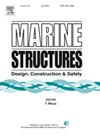Model tests of a stiffness-similar jack-up, Part 1: Model design, fabrication and structural pre-tests
IF 5.1
2区 工程技术
Q1 ENGINEERING, CIVIL
引用次数: 0
Abstract
This paper forms Part 1 of a paper series on jack-up model tests describing model design, fabrication and an extensive set of structural pre-tests. The model tests were aimed to provide high quality data-sets for the development of structural digital twin, therefore realistic and representative model of a jack-up platform at model-scale would be essential. In this regard, a generic jack-up model at 1:30 scale was designed such that the dynamic behaviour at full-scale was representative of actual jack-ups as reported in the literature. The main novelty was the use of Polycarbonate (PC) material to construct the leg structure, such that stiffness-similarity at model-scale could be achieved, both in terms of bending and axial rigidity. The benefits are two-fold. First, this allows direct strain/stress measurements along the legs to obtain axial member forces. Second, foundation fixity and leg-to-hull fixity at model-scale can also be representatively modelled such that the measured boundary forces were meaningful. The design and structural pre-tests of the key components of the jack-up model, which included the legs, spudcan, leg-to-hull connection, hull and cantilever, are thoroughly described in this paper. In general, good linear behaviours were observed, although small non-linear behaviour was noted for the spudcan module at lower loading amplitude. Additional pre-tests of the assembled jack-up model were also conducted prior to the start of model tests, and similar observations were drawn. A numerical Finite Element model of the jack-up was set up using ABAQUS, and in general, good agreement was achieved between measurements and numerical simulations for the boundary forces, moments and strains, as well as the overall dynamic characteristics. The numerical model could form the basis for development of structural digital twin tapping on the model test results for validation and proof-of-concept.
相似刚度自升式平台的模型试验。第1部分:模型设计、制造和结构预试验
本文是自升式模型试验系列论文的第一部分,描述了模型设计、制造和广泛的结构预试验。模型试验的目的是为结构数字孪生的开发提供高质量的数据集,因此,在模型尺度上建立一个真实且具有代表性的自升式平台模型是必不可少的。在这方面,设计了一个1:30比例的通用自升式模型,使得全尺寸的动态行为代表了文献中报道的实际自升式平台。主要的新颖之处在于使用聚碳酸酯(PC)材料来构建腿结构,这样就可以实现模型尺度上的刚度相似性,无论是在弯曲刚度还是轴向刚度方面。好处是双重的。首先,这允许沿着腿进行直接应变/应力测量,以获得轴向成员的力。其次,模型尺度上的基础固定点和腿-船体固定点也可以进行代表性的建模,这样所测的边界力是有意义的。本文详细介绍了自升式模型的关键部件——支腿、支腿、支腿与船体连接、船体和悬臂的设计和结构预试验。一般来说,良好的线性行为被观察到,尽管小的非线性行为被注意到的spudcan模块在较低的加载幅度。在模型测试开始之前,还对组装的自升式模型进行了额外的预测试,并得出了类似的观察结果。利用ABAQUS软件建立了自升式平台的数值有限元模型,结果表明,自升式平台的边界力、弯矩、应变及整体动力特性的数值模拟结果与实测结果吻合较好。该数值模型可为结构数字孪生体的开发奠定基础,并对模型试验结果进行验证和概念验证。
本文章由计算机程序翻译,如有差异,请以英文原文为准。
求助全文
约1分钟内获得全文
求助全文
来源期刊

Marine Structures
工程技术-工程:海洋
CiteScore
8.70
自引率
7.70%
发文量
157
审稿时长
6.4 months
期刊介绍:
This journal aims to provide a medium for presentation and discussion of the latest developments in research, design, fabrication and in-service experience relating to marine structures, i.e., all structures of steel, concrete, light alloy or composite construction having an interface with the sea, including ships, fixed and mobile offshore platforms, submarine and submersibles, pipelines, subsea systems for shallow and deep ocean operations and coastal structures such as piers.
 求助内容:
求助内容: 应助结果提醒方式:
应助结果提醒方式:


